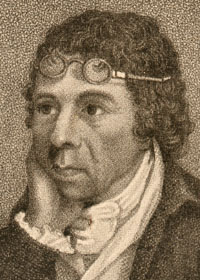 Born
at Hermiston near Edinburgh in 1739. At the age of fifteen, his
parents being dead he undertook the family farm at Monkshill. He
attended Cullen's lectures on chemistry to improve
his agricultural knowledge, and introduced what came to be known
as the Scotch Plough. He was
a man of liberal education; having studied chemistry at Edinburgh,
under Dr. Cullen. He had published several essays
on agriculture and, in 1780, received the degree of
LL.D., from Aberdeen University. Twelve years before, in 1768 he had married Miss
Margaret Seton, of Mounie, by whom he had thirteen children.
In 1788 he moved to Edinburgh where he wrote about the economics
of the North Sea fisheries. He was a contributor to the first edition of the Encyclopcedia
Britannica, and wrote the first report on the Agriculture of
Aberdeenshire, published in 1794.
Born
at Hermiston near Edinburgh in 1739. At the age of fifteen, his
parents being dead he undertook the family farm at Monkshill. He
attended Cullen's lectures on chemistry to improve
his agricultural knowledge, and introduced what came to be known
as the Scotch Plough. He was
a man of liberal education; having studied chemistry at Edinburgh,
under Dr. Cullen. He had published several essays
on agriculture and, in 1780, received the degree of
LL.D., from Aberdeen University. Twelve years before, in 1768 he had married Miss
Margaret Seton, of Mounie, by whom he had thirteen children.
In 1788 he moved to Edinburgh where he wrote about the economics
of the North Sea fisheries. He was a contributor to the first edition of the Encyclopcedia
Britannica, and wrote the first report on the Agriculture of
Aberdeenshire, published in 1794.
Ardent in temperament,
independent in his style of thought, and very outspoken, he took
the keenest possible interest in the agriculture and social life of the region; his
ideas, to which he never hesitated to give vent in one form or
another, being not infrequently in direct conflict with the established order of
things, a circumstance which seems in no way to have disturbed
his equanimity,
marred his good humour, or cooled his enthusiasm. In 1790, he was the
originator, conductor, and chief contributor to a well-known
weekly publication called 'The Bee' or 'Literary Weekly
Intelligencer' which continued until 1794, and in which agricultural, scientific, and other
questions were discussed; and his separate publications, which
include a great variety of subjects, from the construction
of chimneys to the nature and formation of Peat Moss, form
altogether a very long list. In 1797 he moved to Isleworth,
England. Dr. Anderson died 15 October at Westham, near
London, in 1808. DNB; NLS Impr Ind.